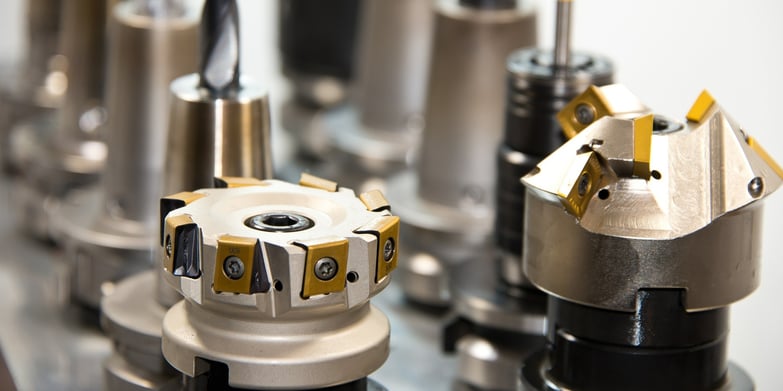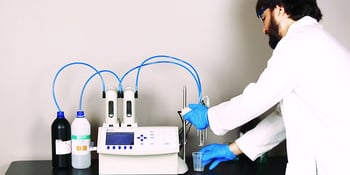
It is no secret that keeping tight controls on the nickel concentration in your electroless nickel-phosphorus (EN) bath is important for maximizing plating efficiency and finish quality. But that is only half of the story.
Sodium hypophosphite is constantly consumed throughout the plating process.
Regular monitoring of hypophosphite ensures that the engine driving the plating is operating correctly.
Better yet, automatic titration of hypophosphite improves consistency, traceability, and accuracy in your results.
Role of Hypophosphite in Electroless Nickel Baths
In order to understand how hypophosphite drives electroless plating, we first should look at the overall reaction. Here’s one of the generally recognized mechanisms for how it works:
- Ni2+ + H2PO2- + H2O → Ni (s) + H2PO3- + 2H+
- H2PO2- + H2O → H2PO3- + H2 (g)
We can see that in this reaction, hypophosphite is responsible for taking the dissolved nickel salts and depositing them onto the substrate (part). Some phosphorus is deposited on the substrate as well. What this means from a bath maintenance perspective is that both nickel and hypophosphite are consumed whenever a part is plated through the electroless nickel process. Specifically, each gram of nickel metal plated onto a part will consume approximately four grams of hypophosphite. The ratio between nickel concentration and phosphorus concentration is crucial to uphold in order to maintain predictable deposition rates and phosphorus content in the overall finish.
Because of the importance of maintaining a nickel-hypophosphite ratio, a typical acid hypophosphite EN tank has 20 to 30 g/L of nickel chloride and 20 to 24 g/L of sodium hypophosphite. However, there is quite a bit of variation in the formulation between different chemical suppliers.
The Key to Measuring Hypophosphite Accurately
Titration is the most common way to measure hypophosphite content in a plating bath. This method uses an oxidation-reduction (redox) reaction, where a known concentration of an oxidizing agent is added to oxidize all of the hypophosphite in the sample. In hypophosphite analysis, iodine is the oxidizing agent added to the sample. Easy enough, right? Not quite.
There is a bit of a twist here - hypophosphite does not react quickly enough with iodine to produce a sharp titration endpoint, making a direct titration difficult. Instead, a back titration is used. With a back titration, the iodine is added in excess so that there is more than enough for all of the hypophosphite in the sample to react with the iodine. The leftover iodine can be titrated with a reducing agent, sodium thiosulfate, to produce a sharp, accurate endpoint.
This titration can be performed manually or automatically. Both methods share the same principle, but use different ways to detect the endpoint.
Titration of Hypophosphite
In order to perform the titration you must obtain the sample, and then add the iodine in excess. It is important to note the exact amount of iodine added to the sample as the volume will be used later in the calculation of hypophosphite. After adding the iodine, the sample must be sealed with a stopper and placed in a dark, cool place for approximately 25 minutes. This period is necessary to allow the iodine to react with hypophosphite.
After this time, the excess iodine is titrated to an endpoint. The amount of sodium thiosulfate is used to calculate the result as follows:
Hypophosphite (g/L) = ((Iodine mLs x Iodine concentration) – (Thiosulfate mLs x Thiosulfate concentration)) x 2.05
* For a 2 mL bath sample
Manual Titration
In a manual titration, you must add the excess iodine by hand. After adding the iodine and waiting the time required for the iodine to react, the excess iodine is reacted with sodium thiosulfate. This time, the titrant must be carefully added to avoid overshooting the endpoint. The sodium thiosulfate is added until the solution is pale yellow. After that, a starch indicator is added and titrated until clear.
Performing this test accurately takes practice and is difficult to obtain consistent results across multiple operators and shifts. The difficulty arises from the subtleness of the endpoint, which can be perceived differently by people. For example, “titrate until clear” has different meanings to different people. The color of the sample can play a factor in judging the endpoint as well.
Automatic Titration – Accuracy, Reliability, and Repeatability
 Automatic titration takes the guesswork out of determining the endpoint of a titration by using an ORP sensor. Instead of relying on a human operator to determine when to stop titrating, automatic titrators monitor the titration and stop at the equivalence point, the discrete point where titrant (thiosulfate) and analyte (iodine/hypophosphite) are present in equal quantities. The titrator even does the calculations for you, making hypophosphite results little more than a push-button away.
Automatic titration takes the guesswork out of determining the endpoint of a titration by using an ORP sensor. Instead of relying on a human operator to determine when to stop titrating, automatic titrators monitor the titration and stop at the equivalence point, the discrete point where titrant (thiosulfate) and analyte (iodine/hypophosphite) are present in equal quantities. The titrator even does the calculations for you, making hypophosphite results little more than a push-button away.
Automatic titration makes the calculations, titrant dosing, and endpoint detection all automatic. This saves bench time, eliminates user error, and makes measurements easier to perform.
Keeping records is easy with automatic titrators as well. Each titration performed on automatic titrators has a report generated that includes the date/time, result, and operating parameters. This makes record keeping easy for maintaining tight controls and for compliance with customer requirements.
What You Need to Measure Hypophosphite
Automating hypophosphite analysis is easy once you have the right materials. If you are performing this test manually, the switch to automatic titration is even easier since all of the same chemicals can be used. Here is a list of everything you need to perform hypophosphite automatic titrations:
- Hanna HI902C Automatic Potentiometric Titrator with ORP electrode
- Beakers
- Graduated cylinder*
- Adjustable pipette*
- 0.1M sodium thiosulfate
- 0.1M iodate (or iodine) solution*
- 25% sulfuric acid
- Concentrated potassium iodide (for iodate only)
- Deionized water
*3rd party materials not supplied with kit
We Can Help Automate Your Titration Process
Automating your hypophosphite analysis is easier than ever. Automated systems can easily be expanded to include other commonly performed tests such as acidity, nickel, and alkalinity. This way, you can benefit from increased traceability, accuracy, and repeatability in all of your titrations.
Hanna Instruments is committed to serving Industrial Plating Companies; our Application Specialists have installed automatic titrators at plating facilities across the US and worked directly with operators to setup testing methods.
That's why we've dedicated our blog as a helpful resource for you to use! Catch up on the latest products, explore industry trends, discover testing tips, learn how to improve results, and more. Got questions? Email sales@hannainst.com.


